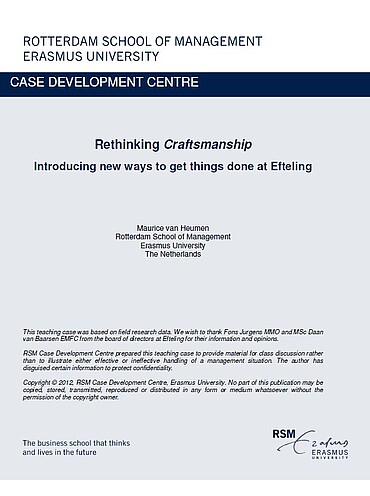Citation Note
Based on field research; 9 pages.
Follow the 'handle' link to access the Case Study on RePub.
For EUR staff members: the Teaching Note is available on request, you can contact us at rsm.nl/cdc/contact/
For external users: follow the link to purchase the Case Study and the Teaching Note.
Objective
This case serves four main objectives: 1. To help students understand the relationship between unique human resources and building competitive advantage. 2. To familiarize them with a method of gap analysis, and low probability but high organizational impact. 3. To stimulate exploration of the concept of ‘total job performance’ where both economic and non-financial values are recognized in delivering value. 4. To help students understand the complex process of make-or-buy decision-making. If used in an executive program, the case also helps answer the following questions that concern many managers of multinational firms: 5. Should a line manager make knowledge sharing and collaboration part of formal evaluations? 6. How to implement new working methods based on non-financial values? 7. How to set performance targets for individual employees?
description
When the Dutch fairytale park, Efteling, made the transition from seasonal to full-year attraction, it also faced the question of whether it should continue developing in-house craftsmanship or outsource these important activities.
Abstract
The Dutch fairytale park, Efteling, had been perceived as a wonderful organization for 60 years and had built a strong competitive advantage in the leisure market. In 2011, Efteling began to make a transition from a seasonal attraction towards offering full-year access to visitors for the first time in their history. This came with major implications for organizing the work of its technical personnel. The old value of technical craftsmanship - a unique combination of using technical knowhow and worker experience built up by trial and error and shaped over years - has contributed to many unique custom-made creations. Efteling's ageing workforce meant that the company was losing significant valuable skills and experience in the technical division. Young, inexperienced workers need time to adjust, and as central management prefers to measure employee’s performance economically, this seriously threatened the organization's overall results. A new working method based on non-financial values was introduced to help central management evaluate the difficult 'make-or-buy' question: Where and when to use the skills, knowledge and experiences of their own technical employees versus which activities could be outsourced.
usage
This case examines a classic topic from a new angle: How to build competitive advantage using a working method based on non-financial values?
